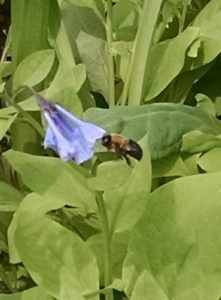by Heather Risher
Doug Tallamy recently spoke as part of the Conservancy for the Cuyahoga Valley National Park’s Lyceum series. His talk was titled, “Restoring Nature’s Relationships at Home,” but really he focused on the food web, particularly the importance of insects.
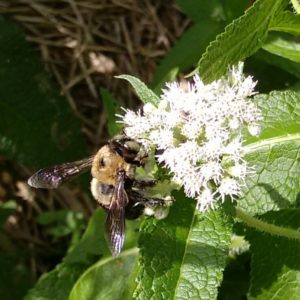
Gardenopolis readers know the importance of planting native species, but Dr. Tallamy focused on a large and diverse group of animals we rarely consider: insects. We talk about planting native species to provide food and habitat for birds, but we don’t necessarily think about what birds eat other than fruit and seeds.
While birds appreciate the seeds, suet, fruit, and sugar water we provide, much of their diet consists of insects, particularly caterpillars that feed their young. According to Tallamy, 96% of terrestrial birds depend on insects. Mammals, reptiles, amphibians, and other invertebrates eat insects, too. We landscape for birds when we should be landscaping for insects.
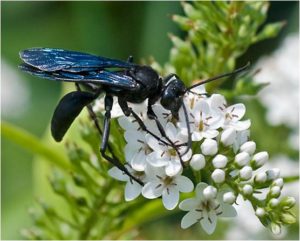
Insects are fundamental to animal life. Everyone depends on insects, from other invertebrates up through humans. Yet the abundance of invertebrates has declined 45% globally since 1971. A large part of the problem is the preponderance of non-native species in our gardens and public spaces. Insects have had millenia to adapt to (specialize on) native species, yet merely a few hundred years to adapt to species introduced to the area. Non-native species don’t support many insects: novel ecosystems don’t have evolutionary history.
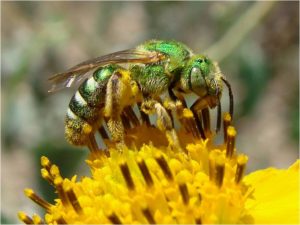
Dr. Tallamy and his students studied insect diversity on native species vs non-natives, and the results were alarming given birds’ reliance on caterpillars. An oak tree might host 400-500 species of caterpillars. An ash tree can host nearly 100 different ash specialists. A Bradford pear provides a home to only a few individuals. Take a look around your home, and it’s likely that you can see at least one Bradford pear. They’re everywhere!
A recent visit to the Cleveland Botanical Garden supported his claim: I saw very few insects throughout much of the garden. The Virginia Bluebells? Covered in bees! I witnessed a bumblebee mating flight near one patch.
Many people panic when they see caterpillars on their trees and shrubs. Dr. Tallamy suggested a 10-step program: Take 10 steps backwards and your “bug problem” will disappear. He reminded the audience that leaves should have some holes, otherwise the plant isn’t supplying energy to the ecosystem.
I strongly encourage readers to peruse Dr. Tallamy’s site, or perhaps this interview. He reminds us of the importance of contributing to our local ecosystem rather than harming it.
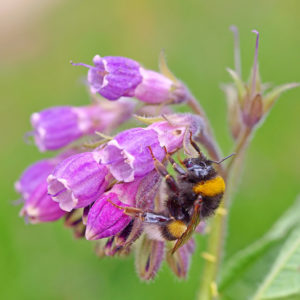
Think of your property, your little piece of the world, as being part of your local ecosystem. The way you landscape your property — the plant choices you make and the amount of lawn you maintain — will determine whether your property is enhancing your local ecosystem or destroying it. As Roy Dennis says, “Land ownership is more than a privilege, it’s a responsibility.”
The Audubon Society and the National Wildlife Federation both have search engines to help people find plants native to their area. Landscape for insects as well as birds!
What might you not know about butterflies?
by Elsa Johnson
How about that the majority of butterflies found in Ohio hibernate here – and you can help them (and other insects).
How? By building a butterfly log cabin (I know, I know – it sounds like a special syrup to put on pancakes, but it’s not). By doing so you provide a place for non-migrating butterflies to hibernate, either as chrysalis, as an adult butterfly, or as caterpillars.
Here’s how (directions taken from www.backyardhabitat.info – for more detail visit this site):
You will need logs. About 2 feet in length; anchoring wood posts for the sides – and some way to drive them into the ground; and some sort of waterproof covering or tarp, one for the bottom and one for the top.
- Choose a sheltered location – on the southeast side of an evergreen, for example. Almost every yard has some sort of out-of-the-way spot where this could be done.
- Start by placing one piece of tarp on the ground. Then place 2 long 4 foot logs sections in one direction on top of the tarp – these 2 logs sections will keep the rest of the structure off the ground and insure air circulation
- Next, place a layer of logs going in the opposite direction. Then add third layer of logs going in the opposite direction to the second layer. After driving your supporting side stakes into the ground, continues building layers in opposite directions until you have a ‘log cabin’ about 3 feet high.
- Place a tarp on top and anchor it down with a few more logs. The tarp keeps the crevices dry.
Here are some of the butterflies that overwinter as chrysalises: Tiger swallowtail, Eastern black swallowtail, Spring azure, Pipevine swallowtail, Spicebush swallowtail, Zebra swallowtail, Silver spotted skipper, and Giant Swallowtail.
As adult butterflies: Mourning cloak, American painted lady, Tortoise shell, Eastern comma, and Question mark butterfly.
And, as caterpillars: Giant spangled fritillary, Wood nymph, Easter tailed blue, Pearl crescent, Viceroy. Silver checkerspot, Red spotted purple, American copper, and Orange sulphur.
